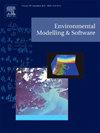在大数据时代为河流形态学研究建立开放式集成网络基础设施
IF 4.8
2区 环境科学与生态学
Q1 COMPUTER SCIENCE, INTERDISCIPLINARY APPLICATIONS
引用次数: 0
摘要
本文旨在介绍一个名为 "河流形态信息系统(RIMORPHIS)"的网络基础设施的初步说明,以解决目前与河流形态数据和工具有关的局限性。RIMORPHIS 由一个用于存储河流形态数据的数据模型提供支持。为河流形态数据集的数据和语义制定了新的规范,以支持基于网络的河流形态数据发现和可视化平台。我们还开发了若干地理处理工具,用于科学分析和实际研究,包括坐标转换、断面生成和水深测量网格生成。我们对 RIMORPHIS 的愿景是创建一个自给自足的社区平台,为河流形态的科学发现提供工具支持,并促进河流环境的多学科研究。为了实现这一愿景,我们创建了一个社区来收集意见和建立合作伙伴关系。RIMORPHIS 网络基础设施满足了社区在数据访问、处理和可视化方面的需求。RIMORPHIS 目前的实施可根据新数据和新工具进行扩展。本文章由计算机程序翻译,如有差异,请以英文原文为准。
Towards an Open and Integrated Cyberinfrastructure for River Morphology Research in the Big Data Era
The objective of this paper is to present the initial illustration of a cyberinfrastructure named the RIver MORPHology Information System (RIMORPHIS) that addresses the current limitations related to river morphology data and tools. RIMORPHIS is supported by a data model for storing river morphology data. A new specification for data and semantics on river morphology datasets has been developed to support the web-based platform for discovering and visualization of river morphology data. Several geoprocessing tools are developed that enable scientific analysis and practical studies, including the coordinate transformation, cross-section generation and bathymetry mesh generation. Our vision for RIMORPHIS is to create a self-sustained community platform with tools to support scientific discoveries on river morphology and to enable multidisciplinary research for riverine environments. To accomplish this vision, we created a community to gather input and build partnerships. The RIMORPHIS cyberinfrastructure addresses the community needs related to data access, processing and visualization. The current implementation of RIMORPHIS is scalable for new data and tools.
求助全文
通过发布文献求助,成功后即可免费获取论文全文。
去求助
来源期刊

Environmental Modelling & Software
工程技术-工程:环境
CiteScore
9.30
自引率
8.20%
发文量
241
审稿时长
60 days
期刊介绍:
Environmental Modelling & Software publishes contributions, in the form of research articles, reviews and short communications, on recent advances in environmental modelling and/or software. The aim is to improve our capacity to represent, understand, predict or manage the behaviour of environmental systems at all practical scales, and to communicate those improvements to a wide scientific and professional audience.
 求助内容:
求助内容: 应助结果提醒方式:
应助结果提醒方式:


